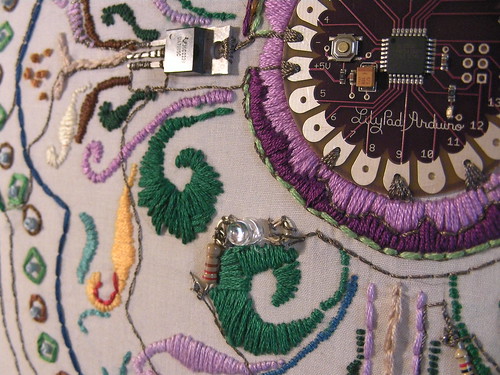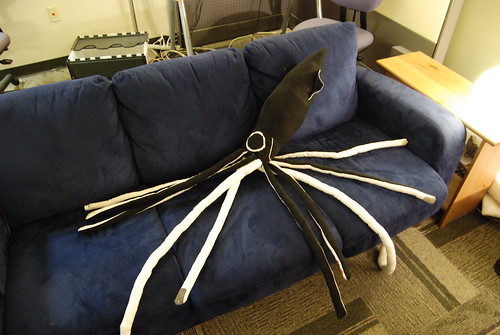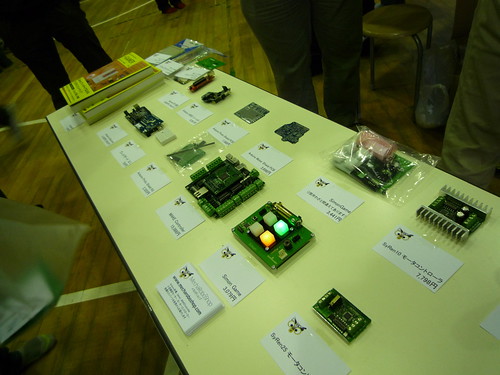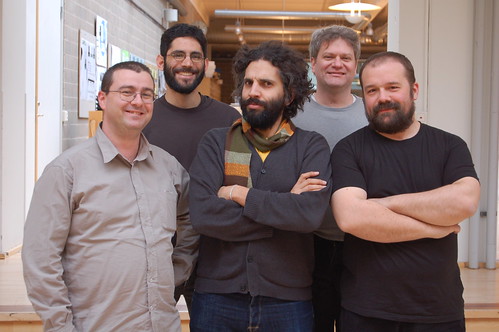FRIDAY NIGHT: BEERDUINO
– May 2nd, 2008
It is Friday night and I am home coding bootloaders for an application of some of my students at K3. In the back I have opened the #arduino IRC channel on the Freenode server where about 30 people are connected talking different issues. Among the most active ones is Scoates from Montrealers.ca, who was featured in Make some time ago for making an Arduino controlled Brewery.
Friday night and Beer sounds like the perfect combination to me. So I asked for some more information and got this article, but also this link where you will get access to the latest update of Scoates’ code to this Arduino NG Beembedded artifact.

Picture courtesy of Sean Coates aka Scoates
I googled a little more and found out a two-days-old post on Makezine about this very same topic. Seems like beer brewing is big in North America. Until it reaches our dear old continent, please enjoy Sean’s pictures.
WEB STATISTICS AT ARDUINO.CC
– May 2nd, 2008
The Arduino Community keeps on growing … at an almost scary pace. The following are statistics taken during the last four months for the www.arduino.cc domain.
| Month | Unique visitors | Number of visits | Pages | Hits | Bandwidth |
| Jan 2008 | 79119 | 171226 | 1234208 | 3353618 | 309.10 GB |
| Feb 2008 | 91402 | 186886 | 1145305 | 3501393 | 344.04 GB |
| Mar 2008 | 102799 | 209713 | 1210673 | 3752178 | 368.90 GB |
| Apr 2008 | 105652 | 220203 | 1410959 | 4241552 | 441.79 GB |
The Arduino server registers an average of 7000 visits/day with a total traffic of 14GB/day. The way people visit the server is quite evenly distributed over the 24 hours of the day.
| /cgi-bin/yabb2/YaBB.pl | 393788 | |
| / | 136229 | |
| /blog/ | 88007 |
This second table shows that the most visited site in April was our forum, followed by the main site and the blog you are reading right now.
A quick analysis of the statistical data shows that there is obviously a huge amount of traffic because of people downloading the IDE. I wonder if people are having trouble with it and if we should consider to encourage people mirroring the IDE at some other places just to avoid long downloading times (opinions/ideas are welcome).
The other scary fact is that we got, on top of the normal visits, about 350.000 hits coming from web robots during April, this means the Arduino site has been replicated about 100 times (we have an estimate of the equivalent to 3400 static pages) at different webcrawlers just last month!!
LILYPAD EMBROIDERY: A TRIBUTE TO LEAH BUECHLEY
– May 1st, 2008
I got this project recommended by one of my Fashion&Technology students. Sternlab presents her embroidery project augmented with sensor technology (one LDR/CDS in this case), leds and sounds. The looks are truly amazing.
As Rebecca Stern (aka Sternlab, currently in the Arts, Media and Engineering Program at ASU) states on her website:
I’ve been working with Leah Buechley’s LilyPad Arduino, and in true embroidery sampler fashion, have composed this circuit to see what I could do. The embroidery uses traditional floss and techniques mixed with lights and sounds generated by the onboard software. The amount of light sensed by the sensor changes the speed and pitch of the lights and sounds generated. Move your shadow or hand over it to experience the changes.
Some other pictures of her projects are:

Detail of the LilyPad Embroidery

SensorSquid: an Arduino based tool for group creativity by R. Stern and L. Tolentino
Disclaimer: all the pictures and video in this article are CC by Sternlab
ARDUINO AT THE MAKER FAIRE – JAPAN
– April 30th, 2008
Mecharoboshop, our latest distributor in Japan, reports from the Maker Faire in Tokyo: “it was only opened 6 hours, but over 600 people showed up, my booth was constantly crowded with people asking questions about Arduino”.

Mecharoboshop at Maker Faire Tokyo (courtesy of Osamu Iwasaki)
There are some links (in Japanese) coming from Make’s blog:
- http://jp.makezine.com/blog/2008/04/thank_you_make_tokyo_meeting.html
- http://jp.makezine.com/blog/2008/04/make_tokyo_meeting_digest.html
It seems that it was an amazing event, when will we get a Maker Faire in Europe? Next week Mecharoboshop will visit the Maker Faire in the US … if you happen to be there, say hi to the guys 
PEOPLE, WORKSHOPS, AND ARDUINOS
– April 29th, 2008
There are many workshops these days where Arduino is used as one of the tools for open development. This week I want to make a quick note on the one made by the people from Hangar.org (BCN, Spain) at Laboral Centro de Arte in Gijon (Spain). The title was TOUCH and they made a revision of different technologies dealing with the sense of touch. Of course Arduino and the classic Qprox sensors were part of the deal, but also important projects like the Reactable(this project is hot indeed) developed at the MTG in Barcelona, the DIYMultitouch interfaces, and others were presented and prototyped during a week of hacking, fun, and Spanish meals.

Picture from one of the examples at the workshop (courtesy of Alex Posada)
If you are interested in the full workshop’s program from Laboral Centro de Arte, you should check this link.
REPRAP CHOOSES ARDUINO FOR FUTURE DEVELOPMENTS.
– March 30th, 2008
The RepRap project just announced the selection of Arduino for the next stage of their efforts to build a self-replicating rapid prototyping machine. We’re flattered and excited to have Arduino playing a part in such a cool project. Kudos to Zach “Hoeken” Smith for persevering through some mysterious bugsto get this working.
The RepRap site has more details about their Arduino-based electronics system.
ARDUINO SUMMIT
– March 26th, 2008
(back) Dave Mellis, Tom Igoe; (front) Gianluca Martino, David Cuartielles, Massimo Banzi
Arduino’s team met during the Easter weekend 2008 for the first time since 2005 when the five member were seen together at a small restaurant in Ivrea, Italy. The group spent three days speaking about the future of prototyping technologies, trying out better ways how to structure the Arduino web-services, testing the forthcoming v0011 (thanks to everybody involved in the discussion process), and analyzing the best ways to improve user experience both on the hardware and software sides.
K3, the School of Arts and Communication at Malmo University, Sweden, kindly sponsored this three days gathering. The snow outdoors wouldn’t allow sightseeing, what helped to work through a much longer agenda than planned.
HIGH-SPEED PHOTOGRAPHY W/ ARDUINO (EXPLODING PEEPS)
– March 24th, 2008
Synoptic Labs took some great pictures using an Arduino as a high-speed photography controller – a nice simple circuit. They shot a pellet gun at peeps (above) and an egg. There’s more information on their blog and more photos on Flickr.
7-SEGMENTS CALCULATOR PHYSICALIZING SECOND LIFE
– February 6th, 2008
The Swedish/Danish duo Gansing/Hilfling has hacked an old calculator to show Second Life’s virtual economics. With the help of Korean media artists Mr. Kim and Mr. Seok, resident designers at K3 – Malmö University, who gave a hand on the technical side of things, an Arduino board was installed inside an old office calculator that would read data from the virtual world to materialize it both on the display and on the calculator’s paper-roll.


Here the official press release:
Calculating “Danmark” – Linda Hilfling/Kristoffer Gansing
February 1 -12 at The Danish National Gallery and in SL
Virtual Moves www.taggingart.org, www.smk.dk
February 1 -12 at The Danish National Gallery and in SL
Virtual Moves www.taggingart.org, www.smk.dk
An intervention into the virtual “Danmark”: During two weeks, an old office calculating machine performs the virtual economics of Second Life.
In 2007 the Danish state joined the hype of the Second Life economy by creating the Island “Danmark”, set up and run by the Danish Tax Ministry. This virtual Denmark reminds Danish Second Life entrepreneurs that the virtual economy is as real as any other and therefore also taxable. But how large is actually the Danish money flow in Second Life?
Calculating Danmark is a comment to how Second Life is branded on its economical possibilities, to such an extent that even nation states feel it is important to join the global venture of this Californian online Disneyland. The calculating machine connects to statistics at SL’s webpage and continuously calculates the average amount of money being spent by Danish users in the virtual world. The data is added together and printed by the machine on a receipt roll. The result is a small amount of money but a lot of paper spilling on the floor.
In 2007 the Danish state joined the hype of the Second Life economy by creating the Island “Danmark”, set up and run by the Danish Tax Ministry. This virtual Denmark reminds Danish Second Life entrepreneurs that the virtual economy is as real as any other and therefore also taxable. But how large is actually the Danish money flow in Second Life?
Calculating Danmark is a comment to how Second Life is branded on its economical possibilities, to such an extent that even nation states feel it is important to join the global venture of this Californian online Disneyland. The calculating machine connects to statistics at SL’s webpage and continuously calculates the average amount of money being spent by Danish users in the virtual world. The data is added together and printed by the machine on a receipt roll. The result is a small amount of money but a lot of paper spilling on the floor.
More images:
http://pzwart2.wdka.hro.nl/~lhilfling/calculating_danmark/hilfling-gansing_calculating_danmark1.jpg
http://pzwart2.wdka.hro.nl/~lhilfling/calculating_danmark/hilfling-gansing_calculating_danmark2.jpg
http://pzwart2.wdka.hro.nl/~lhilfling/calculating_danmark/hilfling-gansing_calculating_danmark3.jpg
http://pzwart2.wdka.hro.nl/~lhilfling/calculating_danmark/hilfling-gansing_calculating_danmark4.jpg
http://pzwart2.wdka.hro.nl/~lhilfling/calculating_danmark/hilfling-gansing_calculating_danmark5.jpg
http://pzwart2.wdka.hro.nl/~lhilfling/calculating_danmark/hilfling-gansing_calculating_danmark6.jpg
http://pzwart2.wdka.hro.nl/~lhilfling/calculating_danmark/hilfling-gansing_calculating_danmark2.jpg
http://pzwart2.wdka.hro.nl/~lhilfling/calculating_danmark/hilfling-gansing_calculating_danmark3.jpg
http://pzwart2.wdka.hro.nl/~lhilfling/calculating_danmark/hilfling-gansing_calculating_danmark4.jpg
http://pzwart2.wdka.hro.nl/~lhilfling/calculating_danmark/hilfling-gansing_calculating_danmark5.jpg
http://pzwart2.wdka.hro.nl/~lhilfling/calculating_danmark/hilfling-gansing_calculating_danmark6.jpg
And some videos:
http://pzwart2.wdka.hro.nl/~lhilfling/calculating_danmark/hilfling-gansing_calculating_danmark-mov1.MPG
http://pzwart2.wdka.hro.nl/~lhilfling/calculating_danmark/hilfling-gansing_calculating_danmark-mov2.MPG
http://pzwart2.wdka.hro.nl/~lhilfling/calculating_danmark/hilfling-gansing_calculating_danmark-mov3.MPG
http://pzwart2.wdka.hro.nl/~lhilfling/calculating_danmark/hilfling-gansing_calculating_danmark-mov2.MPG
http://pzwart2.wdka.hro.nl/~lhilfling/calculating_danmark/hilfling-gansing_calculating_danmark-mov3.MPG
BLINKM SMART LEDS AND OTHER COOL NEW HARDWARE.
– January 27th, 2008

BlinkM is a new smart LED from ubiquitous computing consultancy ThingM. It can smoothly fade to an RGB- or HSV-specified color, randomly fade between nearby colors (for mood lighting), or play back a number of canned, and a single saved, sequence. The compact package contains a bright RGB LED and an AVR microcontroller, and can be connected directly to an Arduino USB board with no additional components. BlinkM is controlled via I2C and up to 127 can be connected to a single Arduino board (or other microcontroller). See thedatasheet for details. There’s also sample Arduino code available for talking to them using the Wire library, and a cross-platform application for graphically creating a color sequence. This is a great way to easily and quickly create cool lighting with an Arduino, and without the use of many pins or much code. You can get a BlinKM for $12.95 from Sparkfun.
I’m guessing that this is only one of many cool products we’ll be seeing fromThingM – these guys have quite a record. In particular, Arduino users may have seen the notes from Tod’s Arduino classes (Spooky Arduino, and Bionic Arduino) and might have heard of Sketching in Hardware, a conference Mike started to bring together creators and users of physical computing platforms and related tools. I’m looking forward to seeing what they come up with next.
ThingM’s not the only company that’s been creating cool new stuff to use with Arduino boards. Libelium, the designers of the Arduino XBee Shield, have recently launched two new products. The GPS module slips onto the pins unused by the XBee shield – great for determining your location and wirelessly transmitting back to a computer (and many other things). The GPRS/GPS shieldadditionally puts your Arduino on the cellular network, letting you send and receive data wherever you are. The RepRap project (to create a self-replicating fabrication machine) has been working on porting their electronics to Arduinoand creating some nice products in the process. Check out their kit which has all the PCBs you need for an Arduino-based RepRap machine. Or if you’re just looking to control some motors, check out the stepper motor driver PCB or thePWM driver PCB.
Those of you looking for something with (significantly) more processing power than an Arduino should check out Bug Labs, which just launched their online store. They’re going to be shipping their BUGbase handheld Linux computer and accompanying modules in March.
If you prefer the smellier side of physical computing (e.g. chemicals and solder), check out these new single-sided serial boards: one from Adilson Akashi and theother from WestFW. Both can be etched and assembled by hand, then bootladed and programmed with the Arduino software. For the absolute lowest-cost, minimum component Arduino-compatible, check out the uDuino instructions. Bitty’s been working on a ZIFduino with a zero-insertion force socket for easy ATmega programming. Limor Fried (a.k.a. ladyada) has sometantalizing new designs posted on Flickr. We’ve haven’t been slacking off either, and hope to have some more to share with you soon. In the meantime, say hello to the newest member of the Arduino team.











0 comentarios:
Publicar un comentario